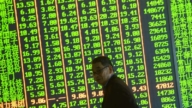【新唐人2012年12月12日訊】12月9號,「西南財經大學中國家庭金融調查與研究中心」發佈《中國家庭金融調查報告》,這份報告顯示,2010年中國家庭收入基尼係數為0.61,這是民間調查的版本。中共所謂的官方版基尼係數,是早在2000年已公布的那個數據0.412,當時的數據已超過貧富兩極分化的所謂「警戒線」。12年過去了,中國的基尼係數不降反增,有學者分析,中國家庭收入貧富懸殊的差距,有可能是壓垮中國經濟社會的最後一根稻草。
「中國人民銀行」與「西南財經大學」共同創立的「中國家庭金融調查與研究中心」,在北京發佈《中國家庭金融調查報告》,報告指出:2010年中國大陸家庭的基尼係數為0.61,遠高於0.44的全球平均水平。
「基尼係數」是國際上作為衡量國民收入分配差異程度的一個指標,比例數值在0和1之間。通常把0.4作為收入分配差距的「警戒線」,超過這條「警戒線」時,貧富兩極的分化,比較容易引起社會階層的對立,從而導致社會動盪。
成都經濟分析師李先生:「中國目前出現貧富差距,這肯定不是甚麼社保、養老造成的,也不是因為經濟發展自然帶來的,因為我工作的關係,我接觸了很多企業,而在中國要達到上億資產的,幾十億資產的,除了當官的,就是和官僚資本相結合,只有這些人才會真正的有錢,所以造成貧富懸殊的,是社會不公,而不是其他原因。」
由於北京在2000年公布最後一次官方的基尼係數:0.412以後,便拒絕再發佈基尼係數,因此2000年以後,中國大陸的基尼係數一直沒有一個確信的數值。
根據統計局的《2011年中國全面建設小康社會進程統計監測報告》中,也僅有「2010年基尼係數略高於2000年的0.412,實現程度為79.8%」這樣模糊的表達。
成都經濟分析師李先生:「我們國家的統計局,他到底是用了甚麼方法算出來的,從去年到現在,物價起碼是漲了一倍,物價在上漲,大家的收入並沒有增加,實際上現在全國人民感受的生活壓力是非常大的,至少人們的切身感受和國家公布的數據是差別很大的。」
美國「南卡羅萊納大學艾肯商學院」教授謝田表示,基尼係數的調節,需要國家通過財政政策進行國民收入的二次分配,例如對民眾的財政公共服務支出和稅收等,從而讓收入均等化,讓基尼係數縮小。
他舉例,美國的基尼指數在0.48%附近,通過政府稅收以後,美國的基尼指數降到0.38左右,反觀中國的稅收並沒有起到調節或減少貧富差距的作用,中共當局也不再公布基尼係數。
美「南卡羅萊納大學艾肯商學院」教授謝田:「透過這個秘密報告,讓我們知道,中共自己確實還在進行這個統計,只是他不把這個數字公布於眾,所以全中國人民以及全世界的人都不知道,但是中國確實處在貧富懸殊非常嚴峻的狀態,所以我想也是個會導致中國社會經濟社會最後崩潰的要素。」
在2011年國民經濟運行情況新聞發佈會上,香港《大公報》記者曾經提問,中國多年的統計資料中都沒有見到基尼係數。當時的統計局局長馬建堂回答說,是因為還沒有建立全國統一的城鄉居民住戶調查體系,沒有取得全國統一可比的居民收入,還不具備計算全國基尼係數的基礎。
對此,外界質疑,2000年以前公布的基尼係數數據,和統計局有關「2010年基尼係數略高於2000年的0.412」,這些數字又是從何而來?
採訪/陳漢 編輯/黃億美 後製/郭敬
China’s Gini Index in 2010 Reaches 0.61
On December 9, Survey & Research Center for China
Household Finance released a survey report.
It showed that China’s Gini index in 2010 is 0.61
China’s last official Gini index 0.412 was made public
in 2000. 12 years later, China sees the Gini soaring.
Professionals speculate that the widening rich-poor gap
may become the last straw that will lead to the end of China’s economy and society.
A China Household Finance Survey report
was released in Beijing.
The report states that China’s Gini index in 2010
was 0.61,far higher than the global average of 0.44.
The Gini index is a number between 0 and 1,
measuring the inequality of national income distribution.
A Gini index of 0.40 is deemed as the “warning level".
Figures above 0.40 indicate a fact of rich-poor polarization.
It may easily cause antagonism among different social
classes and trigger social unrest.
Mr Li (Economic analyst, Chengdu): “China’s rich-poor gap
is definitely not a result of social welfare or pension system.
Nor is it caused by the economic growth.
As a professional, I’ve contacted lots of enterprises.
China’s companies with assets worth over hundreds
or thousands of millions of yuan, which all have an official or semi official background.
Only these people are the real rich in China.
So the reason behind the wide rich-poor gap is
a situation in which social injustice prevails, There is no other reason."
China’s last official Gini index was 0.412, released in 2000.
Since then the communist regime has refused to release the figure.
All other relevant data found was a vague expression
stated in an official statistics & supervision report in 2011.
It said,"The Gini index in 2010 is slightly higher than
0.412 in 2000."
Mr. Li: “How did China’s statistical authorities calculate
those figures ?
From last year until now, prices have at least doubled,
but people』s income has not increased.
In fact, citizens across China are living under great pressure.
At least, one’s personal experience is very different from
what the official data has alleged."
Xie Tian, professor at University of South Carolina-Aiken
Business School, comments.
State fiscal policy can impact the Gini coefficient through
secondary distribution of income account.
Such as public service spending and tax levy, etc..
These can equalize income disparity and lower the Gini.
Xie Tian said, the U.S. Gini index was once around 0.48,
it dropped to 0.38 with tax levy.
By contrast, China’s tax collection has not helped
reduce the rich-poor gap.
Thus, the Chinese Communist Party (CCP) regime
no longer releases the Gini index, Xie Tian remarks.
Xie Tian: “This secret official statistics report shows that
in reality, the regime still makes its own statistical analysis.
But it dares not make public the figure.
Now disparity between the rich and the poor in China is
very serious indeed.
So I think it may be the final impact factor that will trigger
the collapse of China’s economy and society."
In 2011, at a press conference on national economic
performance,
Hong Kong’s Ta Kung Pao reporter inquired about
the lack of release of the official Gini index for years.
Ma Jiantang, then-director of CCP National Statistics
Bureau, replied to the question.
Ma said, this was because a nationwide system had not
been set up for urban and rural household survey.
Nationwide comparable data on resident income
had not yet been obtained.
The basis to calculate the national Gini index does not exist,
according to Ma Jiantang.
That being the case, the public are suspicious
of where the following figures have come from?
Such as the official Gini indices published before 2000,
and the Gini in 2010, which was “slightly higher than 0.412 in 2000″.



























